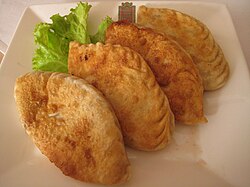Khuushuur
 |
|
| Type | Dumpling |
|---|---|
| Place of origin | Mongolia |
| Main ingredients | Dough, meat (beef or mutton), onions or garlic, salt |
| |
|
Khuushuur (Mongolian: хуушууp [xʊ́ːʃʊr]) is a kind of meat pastry or dumpling popular in Mongolia, similar to Russian and other cuisines' chiburekki. The meat, either beef or mutton, is ground up and mixed with onion (or garlic), salt and other spices. The cook rolls the dough into circles, then places the meat inside the dough and folds the dough in half, creating a flat half-circular pocket. The cook then closes the pockets by pressing the edges together. A variety of Khuushuur has a round shape made by pressing the dough and mince together using the dough roller.
After making the pockets, the cook fries them in oil until the dough turns a golden brown. The Khuushuur is then served hot, and can be eaten by hand.
This type of Mongolian cuisine is similar to buuz in that the meat is prepared in the same way and cooked in a dough pocket, the principal difference being that buuz is steamed instead of fried.
Some Mongolians hold the fresh khuushuur between their palms and also with the tips of all fingers to stimulate the nerves and blood circulation in the hands. This is believed to be curative. In some occasions, a hot khuushuur is placed on the soles of the feet and other selected places to treat neurosis and health conditions related to the balance of the air element of the five elements composing the human body.
...
Wikipedia
